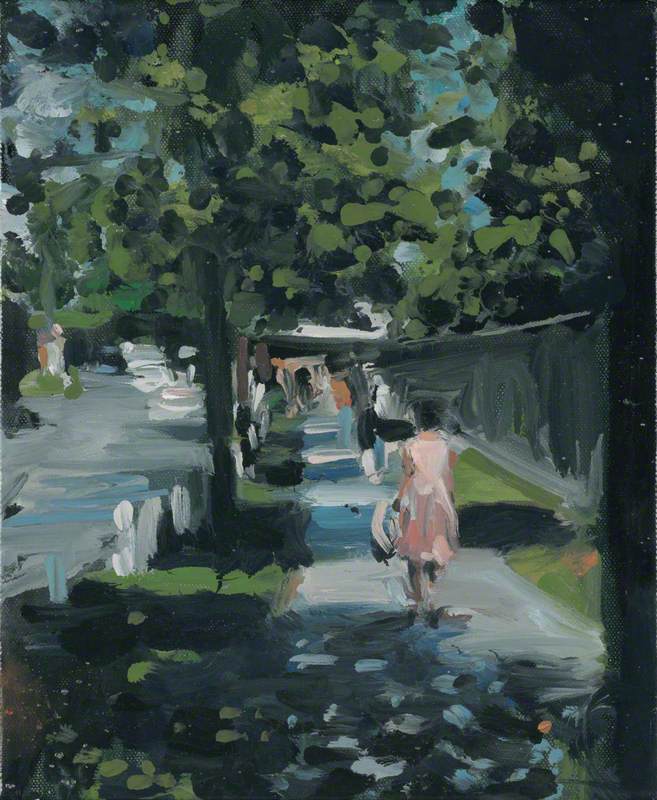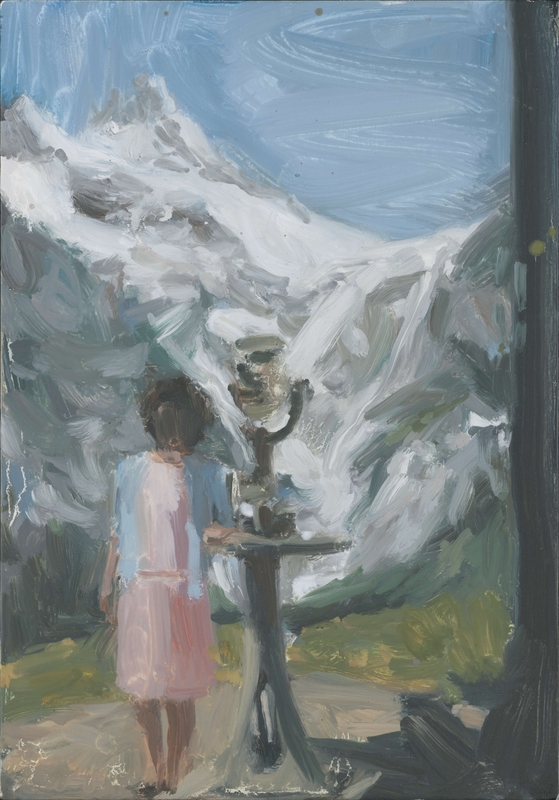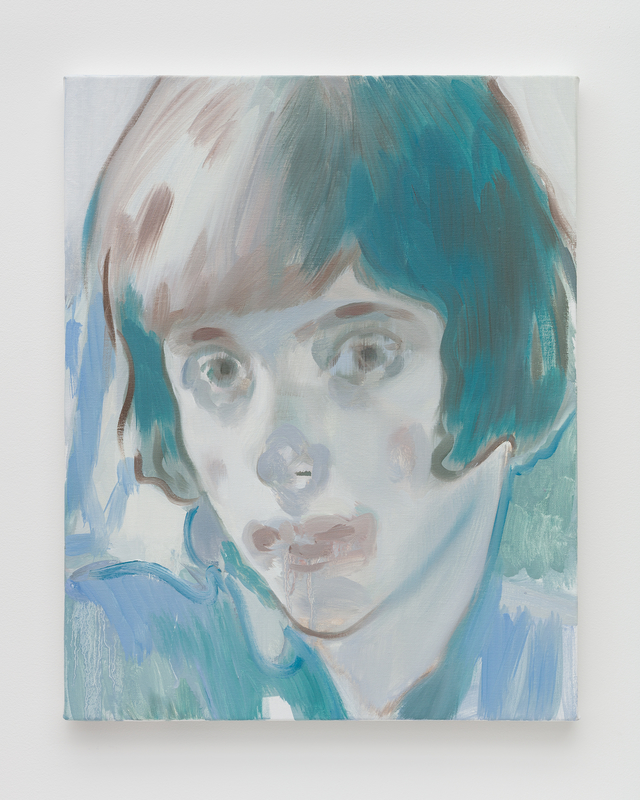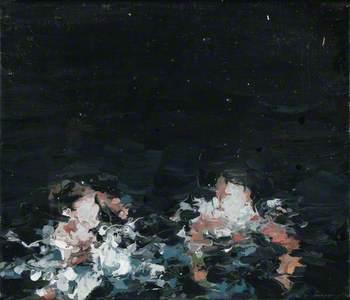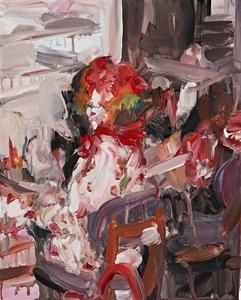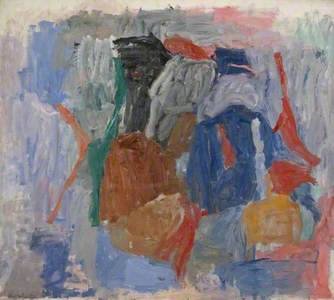In the series 'Seven questions with...' Art UK speaks to some of the most exciting emerging and established artists working today.
Often based on photographs or films found in junk shops or auction sites, the paintings of Laura Lancaster (b.1979) invite us to connect with people and places that feel at once familiar and unknowable. Shifting between abstraction and figuration, Lancaster's often surreal works suggest the fleeting nature of memory and conjure a moment caught in time.
Laura Lancaster
Rooted in the history of painting, Lancaster's work is keen to draw attention to the illusion at the heart of both painting and photography. Asking what it means to look at a painting, she depicts figures – frequently women – with backs turned or gazing directly out of the canvas, as a way of inviting a conversation with the viewer. That her works are based on found material suggests that the image is deliberately open to interpretation. Similarly, her interest in water is another way to point to the fluidity of both paint and painting more broadly.
Born in Hartlepool in 1979, Lancaster graduated from Fine Art at Northumbria University in 2001, going on to have exhibitions at Curwen Gallery, Workplace, London, The New Art Gallery Walsall and Sargent's Daughters, New York.
Her two recent exhibitions, 'In Dreams' at Workplace London, and 'Laura Lancaster: My Echo, My Shadow' at Northern Gallery for Contemporary Art, Sunderland – Lancaster's largest solo show to date – feature new works and suggest an artist in full control of her medium. I talked to Lancaster about reading images, the possibilities of paint and her art-historical influences.
Edward Richards: Your paintings utilise discarded photographs that you find at junk shops and flea markets. How did you land on this way of working, and what is it about the position or status of these photographs in these contexts that interests you?
Laura Lancaster: There is something about the images coming from real lived experience which resonates with me – they have the potential to tap into collective memory in various ways, as they have a sense of familiarity to them. They feel like images that we have seen before, which hopefully draws the viewer into the work.
In many ways, using anonymous snapshots lets the work speak about the broader idea of capturing a moment on film or in paint, rather than the specific subject. In terms of information, I am on a similar footing to the viewer of the paintings as I don't know any more about the context of the source images than the viewer does. This interests me, as it encourages collaboration with the viewer, encouraging them to draw upon their own experience and memories in order to interpret the work.
Edward: Can you tell me about your use of moving image, and how this aligns or differs from your approach to still snapshots?
Laura: I have made paintings based upon found anonymous home movies filmed on Super 8 cine film. This was interesting as it really highlighted the film as a physical object, in terms of running it through projectors and various other equipment in order to select specific film stills. I feel there's an analogy with painting in terms of the mechanics of how an image is made and how various elements come together to create an illusion or image.
The idea that painting reanimates these inert images is something I'm very much concerned with, and the tension between stillness and movement is something which is even more present when using moving images as the source for my paintings.
I'm drawn to the randomness of using found images – these poetic moments drawn from the everyday. It's exciting to play a home movie and have no idea what is on the reel beforehand – it could be completely banal or it could be something amazing, and it unfolds before your eyes. Again, this could also be said for the process of painting.
There's an interesting opportunity to play with format in the moving image-based work – using multiple panels for example. Some diptychs are based upon the first and last frames of home movies placed one upon the other, and there are 24-part works based upon 24 consecutive film stills, which represent one second of time (based upon a frame rate of 24 frames per second).
The moving image-based work is larger in scale. I was looking to appropriate the physical presence of some of the Abstract Expressionists, to do my own version of this monumentally scaled work without the machismo traditionally associated with that artistic movement. I am aiming for my work to have a painterly authority balanced with a knowing ambiguity.
Living in a Memory
2024, oil on linen by Laura Lancaster (b.1979) 
Edward: You paint solitary figures as well as groups. Is there a connection between being alone and being with other people that you are keen to explore?
Laura: I think different things happen psychologically when looking at single figures or groups. They also operate differently depending on whether the subject is 'aware' of the viewer and meets their gaze or is oblivious to them in their own world. There's no one specific way to read this. I'm interested in exploring the ways in which this can change the reading of the painting.
Installation view, 'Laura Lancaster: In Dreams', Workplace, 2024
Showing 'Visitors' (2024) 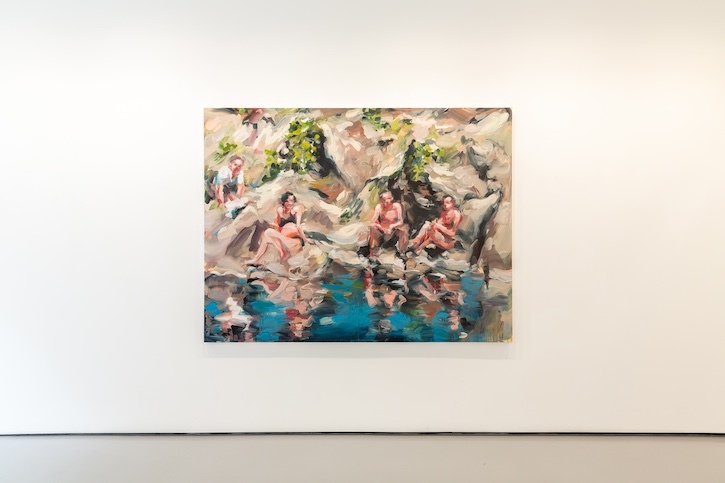
Edward: In some of your paintings, the subjects are aware of being watched, looking back at the viewer. In others, they are unaware. What is it about the act of looking that interests you, and how does this play into your choices with compositions?
Laura: I'm interested in creating an encounter between the viewer and the painting, and in holding them in the moment of looking. Maybe this is because it's the way in which I view paintings myself. I am interested in how the image breaks down, in how I am seeing what I'm seeing as I experience a painting, in all of the tensions that can be housed within a seemingly simple image.
Especially now, in contemporary society, we are bombarded with visual input which is fleeting via the internet, screens, social media. It feels necessary to have a counterpoint to that in which viewing a painting can be slow, quiet, open-ended, ambiguous. I am conscious of this in terms of the composition of my paintings.
Some paintings are more directly related to that of the source photograph, and some are more heavily edited or manipulated. In my paintings, there are different speeds at which the image 'reveals' itself. Some images are easier to read than others in terms of identifying the subject. This is another way in which the viewer can get drawn into the painting, and the act of looking becomes a collaboration between themselves and the work.
Some of the work in the exhibition 'In Dreams' at Workplace has a horizon line which is not level, intended to create a sense of movement and instability in the image, especially in the large-scale work. I am conscious of how the body relates to the scale of the paintings, how larger work can envelop the viewer and smaller work invites a more intimate reading. This all feeds into the choice of scale for a particular composition.
Installation view, 'Laura Lancaster: In Dreams', Workplace, 2024
Showing 'A Stranger's Light' (2024; left) and 'Gathering' (2024; right) 
Edward: You have previously talked about exploring paint as 'the substance of illusion'. Could you tell me about how your gravitation towards a substance capable of creating illusion relates to your process of using photographs?
Laura: In many ways, the source images provide a jumping-off point for the dance between painting and illusion to begin, for the process of description and obfuscation to take place. There's a visual density to photographs and an internal sense of light to them which I am trying to get across in the paintings.
The Day Gathered In
2024, oil on linen by Laura Lancaster (b.1979) 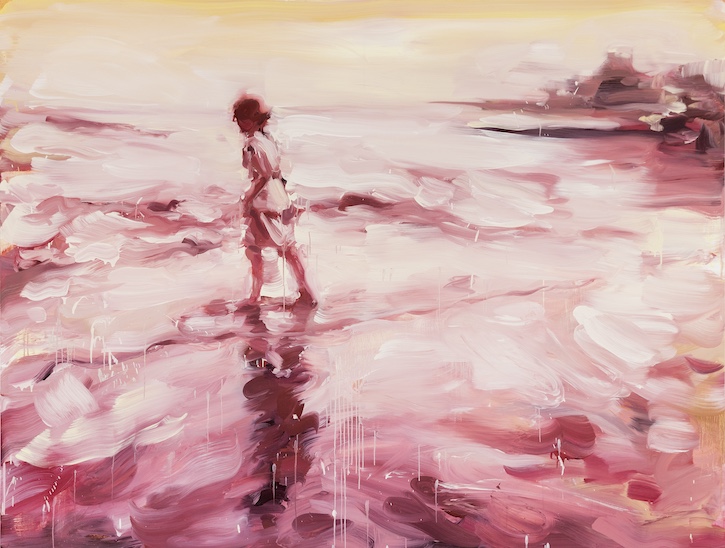
Edward: Your paintings often feature water. I am curious as to whether you think water, as a substance, speaks to the illusion-making property you identify in oil paint. What is it about water, or landscapes near water, that interests you?
Laura: There's a sense of movement and fluidity to both water and paint, a sense of liquidity which lends itself to the feeling I want my paintings to have. I have an awareness of how the eye flows around a painting when viewing it, and how this animates the stillness of painting. Your eye retraces the steps of the painter and how the marks were put down.
Shaking Through
2023, oil on linen by Laura Lancaster (b.1979) 
Images reflected on water are impermanent which relates to photography and painting in terms of capturing something fleeting and temporary, fixing an image which would otherwise disappear unnoticed. There is also something about a sense of displacement which imagery of water has in common with painting.
Dreamer
2023, oil on linen by Laura Lancaster (b.1979) 
Water is complicated to paint and reflects everything around it, and I like the painterly challenge of trying to break this complexity down and remake it in paint. Paint is literally a suspension of pigment and oil and seems to lend itself to the depiction of water, of swimmers suspended or rocks floating in water. It's a place where the play of abstraction and figuration, or presence and absence can play off of each other, in much the same way as the figures in landscapes can combine and come out of focus, the figure is lost and found within their surrounding environment.
The painterly depiction of water and landscapes is a common theme within art history and I wanted to see how my own version of these classical subjects would look, to see how I could contribute to this history in my own way.
Edward: I'd love to hear your thoughts on painting more broadly, and how you feel your work sits within the history of the medium. This year marks the 150th anniversary of Impressionism. Are you inspired by works from this time or any other time period?
Laura: I am inspired by whatever resonates with me, from various eras or artistic movements rather than specific time periods. Recently I have been looking at the technique of John Singer Sargent in terms of building an image tonally.
Goya, and Rembrandt's later work, as well as Francis Bacon and Philip Guston, are painters I return to.
The depiction of the play of light and the sensitivity to colour of the Impressionists' work is something which continues to influence me. When painting is going well it feels like I am almost painting with light, like there is a sense of luminosity coming out from the canvas. Creating this with what is, essentially, coloured mud is an addictive, fascinating process. I tend to be drawn to painters who walk a line between facility and abandon, between off-handedness and total conviction.
Edward Richards, writer
This content was supported by Jerwood Foundation
'Laura Lancaster: My Echo, My Shadow' at Northern Gallery for Contemporary Art, Sunderland, runs until 30th June; 'In Dreams' at Workplace London runs until 5th July
